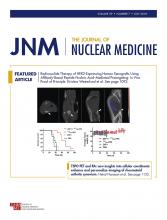REPLY: We thank Laffon et al. for their comments on our paper on a new bacterial imaging PET tracer (1). In their Letter to the Editor, they took keen interest in the different shapes of the time–activity curves of 6″-18F-fluoromaltotriose in an Escherichia coli–infected mouse muscle and its contralateral noninfected control muscle. By incorporating the peak times of the 2 curves and calculating the tracer release rate constant kB using a method with several underlying assumptions (2), they estimated the input function (IF) time constant α after its peak. They found an approximate 10-fold difference in α for the control and bacteria-infected muscle curves. They reasoned that while the value of α for the infected muscle was plausible, the value of α for the control muscle was not realistic. To explain this discrepancy, they suggested an exponentially time-decaying uptake rate constant for the control muscle. They claimed that a time decay of the tracer uptake rate is equivalent to an apparent increase in the IF time constant α, leading to a peak time of the tissue time–activity curve earlier than without saturation (3).
Although we appreciate the explanation offered by Laffon et al., we respectfully disagree with their proposed argument. We do not think an uptake saturation is occurring in the control muscle. When we convolve the image-derived IF from the left-ventricle blood pool to a 2-tissue-compartment model (something which Laffon et al. could not do because they did not have access to the actual IF), the fitted result is very much like that of the time–activity curve of the control tissue (Fig. 1). This, by itself, indicates that there is likely no saturation in uptake (the speculation made by Laffon et al.). If there was truly tissue uptake saturation, one would not likely be able to fit the control muscle time–activity curve with a linear model (i.e., a compartmental model).
Plots of the image-derived IF, the average measured control muscle time–activity curve, and the compartmental model fitted curve. The influx rate constant Ki for the control muscle was estimated to be 0.001084 ± 4.475E−5 mL/min/g (very low as expected for noninfected muscle). If there was tissue uptake saturation, one would not likely be able to fit the control muscle time–activity curve with a linear tracer kinetic model.
To better explain the different shapes of the 2 curves, we believe the issue is more related to the time–activity curve of the active bacteria muscle site. For example, what was the state of the bacteria in tissue 24 h after injection? Was the vascular supply or perfusion to the infected tissue changed? Was the first-pass extraction fraction of the tracer in the infected tissue close to 100%? There are many different but more plausible reasons that could explain the different shapes of the 2 time–activity curves, and would certainly need to be investigated further.
Nevertheless, we and Laffon et al. all agree that 6″-18F-fluoromaltotriose is an exciting new PET tracer that could potentially play an important role in the diagnosis of infectious diseases of bacterial origin as well as in the assessment of antibiotic therapy. Indeed, this new molecular imaging tracer will help us to better understand bacterial biology in living subjects.
Footnotes
Published online Apr. 13, 2018.
- © 2018 by the Society of Nuclear Medicine and Molecular Imaging.








